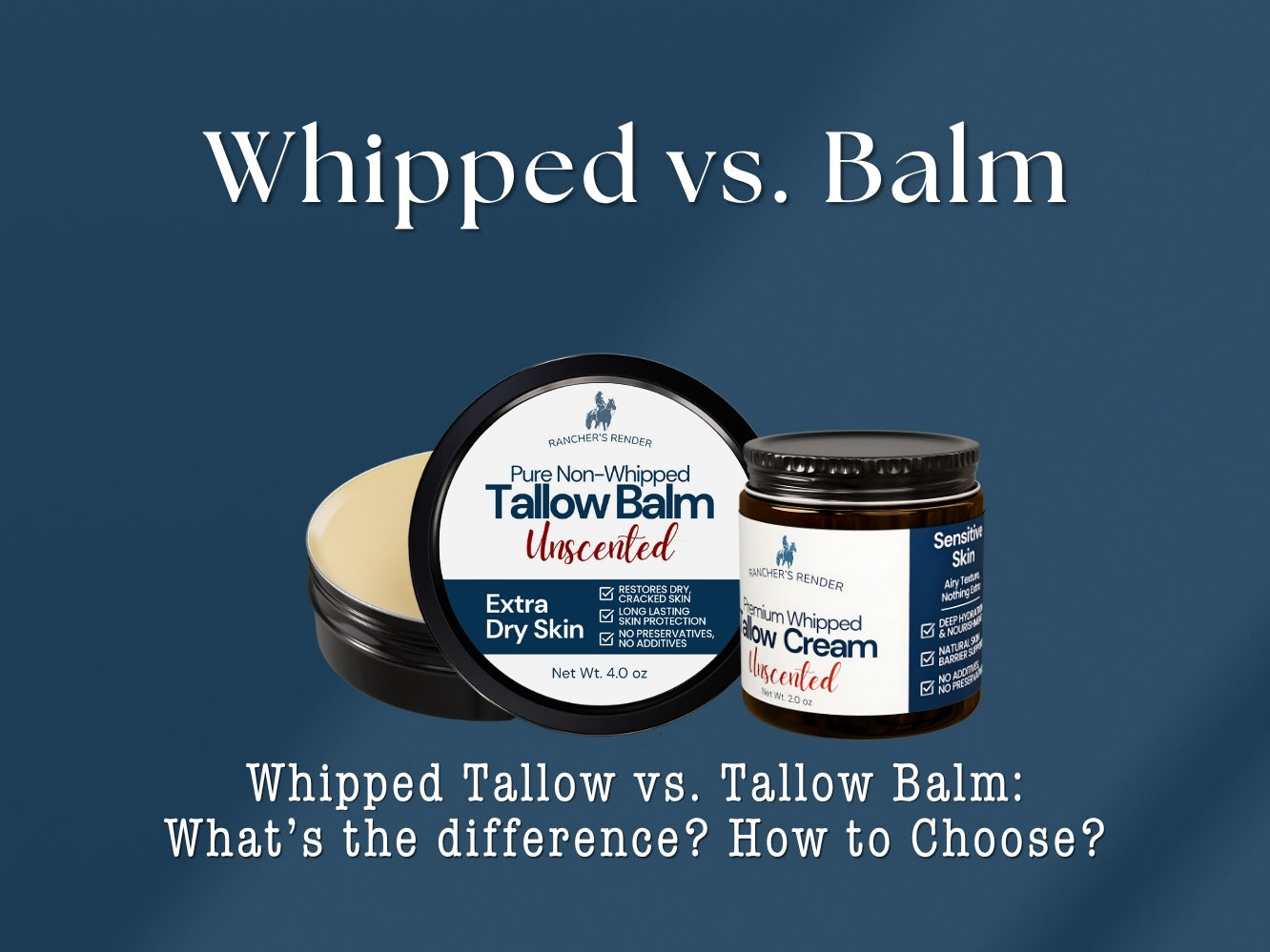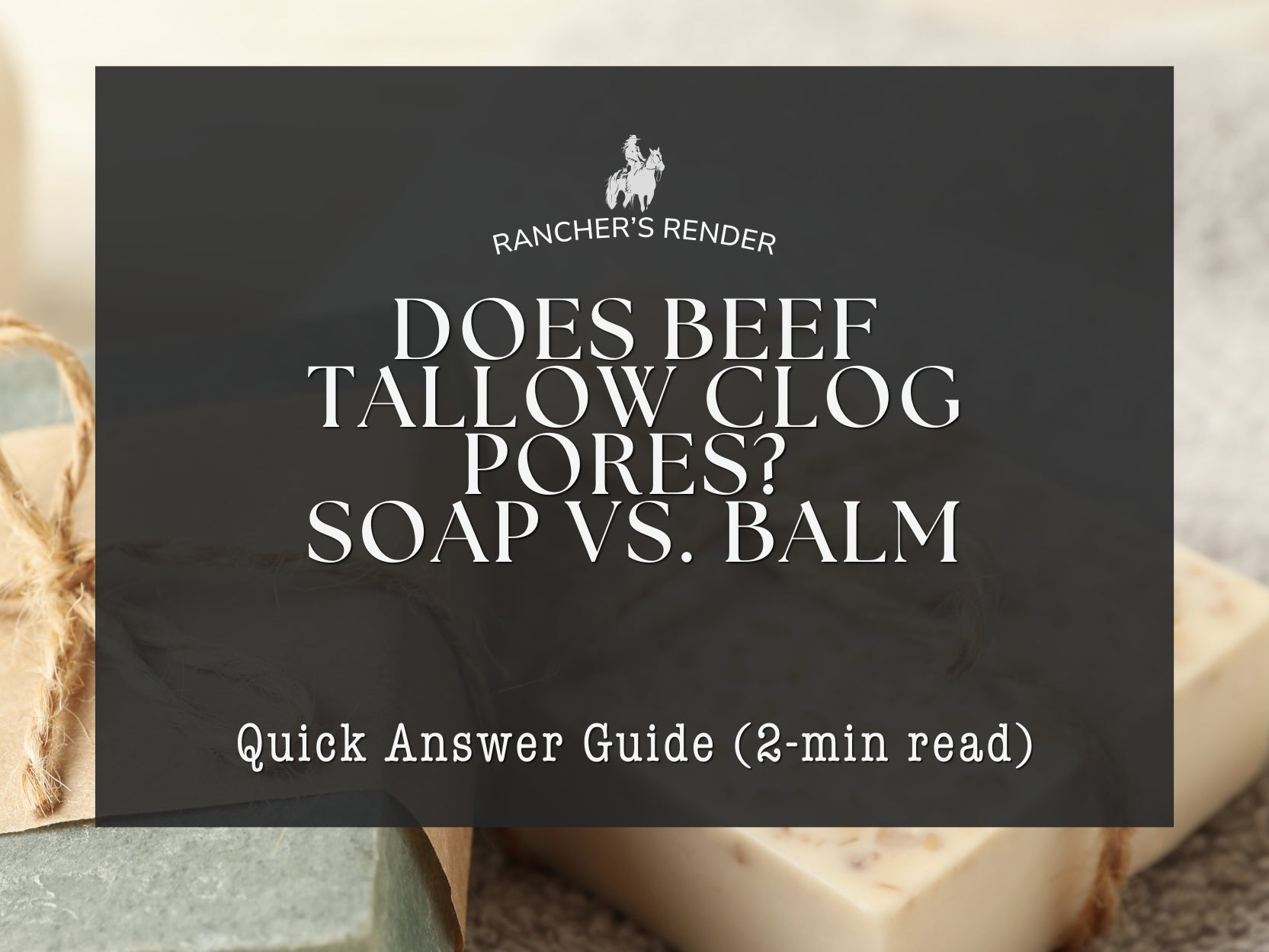If You've Just Bought Your First Tallow Soap, Start Here
If you've just bought your first tallow soap, you might be wondering if there's a special way to use it.
Good news: the basics are exactly what dermatologists recommend for any face washing.
Bad news: most people do those basics wrong. Let's fix that! : )
Whether you're switching from commercial cleansers or you're new to bar soap entirely, this guide will walk you through everything you need to know. The truth is, washing your face with tallow soap is easy. Just like with any type of soap, doing it right makes the difference between glowing skin and unnecessary irritation.
First, Master What Every Dermatologist Recommends
Before we get into anything tallow-specific, let's cover the universal rules that apply to ANY cleanser. Get these basics wrong, and it doesn't matter how good your soap is.
Water Temperature Is Everything
Lukewarm water for washing, cool water for rinsing—this is non-negotiable. Most people use water that's way too hot because it feels good, but hot water strips your skin's natural oils and damages your moisture barrier. Cold water doesn't effectively remove oil and dirt. Lukewarm water cleanses without damaging, while a cool rinse at the end refreshes and helps tighten skin.
Test the temperature on your wrist first. If it feels comfortable there, it's safe for your face.
The Twice-Daily Rule
Dermatologists agree: wash your face twice a day, period. Morning washing removes the oil and bacteria that accumulate overnight (yes, even while you sleep).
Evening washing removes the day's accumulation of dirt, pollution, sunscreen, and makeup. The only exception is adding a third wash after heavy sweating—sweat mixed with bacteria is a recipe for breakouts.
Timing Matters More Than You Think
Most people rush through face washing in 10 seconds flat. That's not enough time for any cleanser to work properly. Dermatologists recommend 30-60 seconds of actual cleansing time—not including wetting your face or rinsing. Think that sounds long? Time yourself next time. You're probably washing for less than 15 seconds.
Your Hands Are Your Best Tools
Forget washcloths, skip the scrubbing brushes, ignore those spinning gadgets. Dermatologists consistently recommend using just your fingertips, and there's good reason why. Washcloths harbor bacteria and are too rough for delicate facial skin. Brushes can cause micro-tears. Your fingertips provide the perfect amount of gentle pressure.
Use circular motions, working from the center of your face outward. Don't forget your jawline and hairline—these areas trap oil and product buildup that everyone misses.
Rinsing: The Step Everyone Rushes
Incomplete rinsing is one of the biggest face-washing mistakes. Leftover cleanser residue clogs pores and causes irritation. Count out your rinses: about 10 splashes with lukewarm water to remove the soap, then 3-5 splashes with cool water to finish. Yes, actually count them. Make sure you hit your hairline, jaw, and in front of your ears—these spots love to hide soap residue.
The Right Way to Dry Your Face
Pat, don't rub. Rubbing irritates skin and can cause broken capillaries over time. Use a clean towel—and by clean, we mean one you change at least 2-3 times per week. Your face towel shouldn't be the same one you use for your hands. Leave your skin slightly damp when you finish; this helps your moisturizer absorb better.
What Makes Tallow Soap Different
Now that you know the universal rules, let's talk about what makes tallow soap unique. The good news? It's mostly the same process with a few minor adjustments.
The Lather Difference
Tallow soap creates a different type of lather than commercial cleansers. Instead of light, airy foam, you get a dense, creamy lather. This is actually better—it means more moisturizing properties and less stripping action. The key is to always work up the lather in your hands first, never directly on your face. Wet the soap, rub it between your palms, add a few drops of water, and create that creamy consistency. This takes about 10 seconds but makes all the difference.
"Like Dissolves Like" - Why Tallow Works
Here's where tallow soap truly shines. Its molecular structure is remarkably similar to human sebum, your skin's natural oil. In chemistry, there's a principle called "like dissolves like"—substances with similar structures dissolve each other effectively.
For your face, this means tallow soap can dissolve excess oils and impurities WITHOUT stripping your skin's protective barrier. It's like your skin recognizes tallow as a friend, not a foreign invader. This is why tallow soap works for both oily and dry skin—it removes what needs to go while leaving what needs to stay.
Timing Adjustments for Your Skin Type
While standard cleansing time is 30-60 seconds, tallow soap lets you customize based on your skin's needs.
If you have oily or acne-prone skin, keep it quick—just 5-10 seconds of actual contact time. Yes, really that short. The soap will still clean effectively without over-stripping.
Normal skin does well with the standard 30 seconds.
Dry skin can benefit from the full 60 seconds, using the extra time for gentle massage to boost circulation.
The Two-Week Adjustment Period
Fair warning: your skin might act weird for the first 1-2 weeks. Some people get oilier, others get drier. This is completely normal. Your skin has been trained to respond to whatever cleanser you were using before. When you switch to tallow soap, your oil production needs time to recalibrate. Don't judge the results until you've used it consistently for at least two weeks.
Your Complete Step-by-Step Routine
Let's put it all together into a simple routine you can follow every morning and night.
Step 1: Prep (5 seconds) Hair back, hands wet, test water on wrist—should be lukewarm.
Step 2: Wet Face (5 seconds) 3-4 splashes of lukewarm water until face is damp.
Step 3: Create Lather (10 seconds) Wet soap, rub between palms, add water drops for creamy consistency.
Step 4: Apply and Massage (10-60 seconds based on skin type) Start at forehead, circular motions to cheeks, gentle on nose and eyes. Include neck and jawline.
Step 5: Rinse (15 seconds) 10 splashes lukewarm water, then 3-5 cool water splashes. Check hairline and ears for residue.
Step 6: Dry and Moisturize (10 seconds) Pat dry with clean towel, apply moisturizer to damp skin.
Total time: About 1-2 minutes. That's it.
No complicated rituals, just good technique.
The Mistakes That Sabotage Your Results
Even with the best tallow soap, these common mistakes can ruin your results.
Mistake #1: "More Lather = Better Clean"
Wrong. Tallow soap is concentrated—you need far less than you think. A mountain of bubbles doesn't equal better cleansing. You want a creamy consistency, not a foam party. Too much product just means more rinsing and potential residue.
Mistake #2: "Hot Water Opens Pores"
This myth refuses to die. Pores don't have muscles—they can't open and close. Hot water just irritates your skin, strips natural oils, and causes redness. Lukewarm water cleans just as effectively without the damage. Save the hot water for your body, not your face.
Mistake #3: "Scrubbing Gets a Deeper Clean"
Aggressive rubbing doesn't clean better—it just causes irritation and micro-tears in your skin. Gentle pressure is all you need. The soap's chemistry does the work, not your muscle power. If you're scrubbing hard enough to move your skin around, you're scrubbing too hard.
Mistake #4: "Leaving It On Longer = More Benefits"
Cleanser is for cleansing, not treatment. Leaving soap on your face for several minutes doesn't increase benefits—it increases dryness and irritation. Even the most moisturizing tallow soap is still soap. Stick to 60 seconds maximum.
Mistake #5: "Once a Day Is Enough"
Skipping morning or evening cleansing leads to buildup. Overnight, your skin produces oil and sheds dead cells. During the day, you accumulate environmental pollutants. Both need to be removed. The only time once-daily might work is if you have extremely dry, sensitive skin—and even then, most dermatologists recommend twice.
Mistake #6: "Any Towel Is Fine"
Your face towel shouldn't be your hand towel, and it definitely shouldn't be the towel you've been using all week. Bacteria multiply quickly on damp towels. Use a dedicated face towel and change it every 2-3 days minimum.
When Things Don't Go As Planned
Sometimes, even when you follow all the rules, your skin doesn't cooperate. Here's how to troubleshoot.
"My Skin Feels Tight After Washing"
First, check your water temperature—it's probably too hot. If that's not it, you might be washing too long; try reducing to 30 seconds. You might also need a higher superfat soap (7-8% instead of 5-6%). And make sure you're moisturizing immediately after patting dry.
"I'm Breaking Out More"
This could be the 1-2 week adjustment period—wait it out before making changes. If it persists, reduce your cleansing time to just 5-10 seconds. Make sure you're rinsing thoroughly with those 15 splashes. Also check if your soap's superfat percentage is appropriate for acne-prone skin (should be 5-6%, not higher).
"It Doesn't Feel Clean Enough"
You might not be rinsing enough—add 5 more splashes and see if that helps. For heavy makeup or sunscreen, try the double cleanse method. Your soap's superfat might also be too high for your oily skin; look for something in the 5% range.
"The Soap Won't Lather"
Add water more gradually—tallow soap needs less water than you'd expect. Let the soap warm up in your wet hands for a few seconds first. If you have hard water, you'll need more product to get a good lather; that's just chemistry.
Advanced Techniques (Once You've Mastered Basics)
After you're comfortable with the standard routine, these variations can address specific needs.
The Double Cleanse Method
Perfect for removing heavy makeup or water-resistant sunscreen. First, apply tallow cream or balm to your dry face and massage for 30 seconds. Wipe with a warm, damp cloth. Then follow with your standard tallow soap routine. This ensures everything is removed without harsh scrubbing.
The Quick Morning Refresh
For oily skin that doesn't need full morning cleansing, try this: 5-second soap application focusing only on your T-zone (forehead, nose, chin), rinse with cool water, and follow immediately with lightweight moisturizer. Takes 30 seconds total.
The Dry Skin Luxury Method
When your skin needs extra care, apply lather to barely damp (not wet) skin. Use extra creamy lather and take the full 60 seconds for massage. Rinse with room temperature water instead of cool, and apply moisturizer to very damp skin for maximum hydration.
The Bottom Line
Washing your face with tallow soap isn't complicated. Follow the same dermatologist-approved basics you'd use with any cleanser: lukewarm water to wash, cool water to rinse, gentle fingertip application, 30-60 seconds of cleansing, thorough rinsing, and gentle drying.
The only tallow-specific adjustments? Create lather in your hands first, adjust timing for your skin type, and give it two weeks before judging results. Your skin knows what to do with tallow—it's been recognizing and utilizing similar fats for thousands of years. Your job is just to apply it properly and get out of the way.
Remember: gentleness beats aggression, consistency beats perfection, and lukewarm water beats everything else.
Most importantly, listen to your skin. It will tell you if you need to adjust your technique, timing, or frequency. Start with the basics, master them, then customize based on what your skin tells you.
Ready to Try It?
Shop Our Handcrafted Tallow Soap Bars →
Tallow for Ance-Prone Skin? (Quick Answer)
Get a Quick Summary Here →
Have questions about your specific skin type? Drop them in the comments below. Real person here, and yes, we actually read and respond to every single one.









